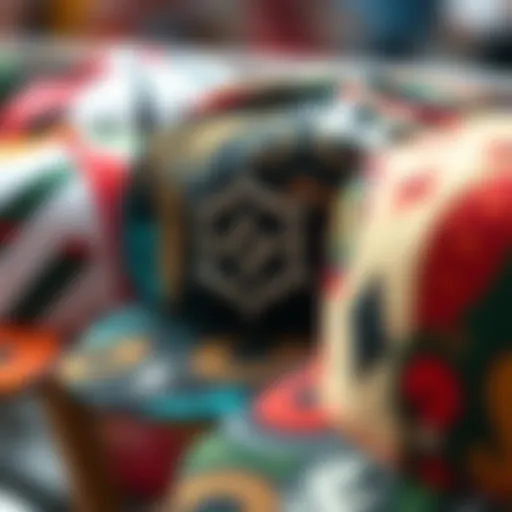Low Key Clothing in Skate Culture: A Deep Dive
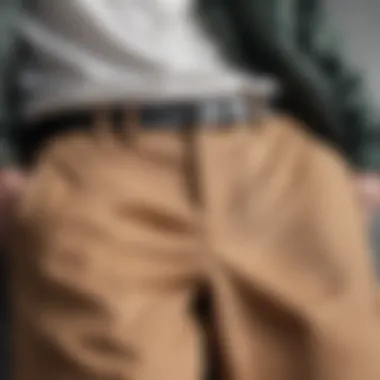

Intro
Low key clothing has carved out a unique niche within the larger canvas of skate culture. This isn’t about chasing the wind or following the latest hype. Instead, it’s a style manifesting comfort and individuality. Just as a skater navigates the concrete jungle, their attire reflects not just taste, but a certain attitude that distinguishes them from the masses.
To genuinely grasp low key clothing in the skateboarding realm, one must consider its roots. Influenced by a blend of practicality and street sensibility, these threads speak volumes. They tell stories of countless hours spent perfecting tricks at skateparks or cruising down city streets. Skate culture, often grounded in rebellion and authenticity, makes every garment a canvas for personal expression.
So, what makes clothing low key? It’s the subtlety in design, the choice of materials, and the way these pieces complement both the activity and the skater’s unique flair. Unlike mainstream fashion, low key pieces often blend into the background, allowing the skaters themselves to shine. In this piece, we’ll peel back the layers of this intriguing phenomenon, exploring not just its characteristics but how it has become synonymous with the skater’s lifestyle.
Through our exploration, we will uncover various styles, indispensable fabric preferences, and pro tips for curating a wardrobe that speaks to the heart of skate culture. Join us as we dive deeper into the aesthetics that underpin both function and fashion in the world of low key clothing.
Understanding Low Key Clothing
Low key clothing operates on a subtle spectrum within skate culture, casting aside the flashiness synonymous with mainstream fashion. This topic holds significance not just for style aficionados, but also for anyone grappling with the challenge of expressing individuality while embracing comfort. Skateboarding isn't merely about perfunctory movement; it's a lifestyle deeply rooted in communal ideologies and personal expression. The essence of low key clothing strikes a balance between relaxed aesthetics and practical functionality, making it essential for both enthusiasts and casual skaters alike.
Defining Low Key Clothing
Low key clothing can be succinctly described as attire that prioritizes comfort and subtlety over ostentation. Consider the oversized hoodies, straight-cut jeans, or simple graphic tees that made their way to the skate parks. These pieces are revered for their ability to allow unencumbered movement while still emanating a casual cool. In a world where everyone is seeking to stand out, low key fashion opts for an understated approach; it’s about dressing with intention without the need for extravagance.
Some key characteristics of low key clothing include:
- Comfort Above All: Prioritizing materials and cuts that enable unfettered movement.
- Practical Design: Pockets, durable seams, and breathable fabrics add to the functionality.
- Neutral Tones: Often, low key wear embraces a palette of earth tones and muted colors rather than bright neon colors.
Historical Context within Skate Culture
To fully appreciate low key clothing, one must venture into its historical context within skate culture. Emerging in the 1970s and 80s, skateboarding was more than a sport; it was a rebellion against mainstream norms. Skaters adopted casual wear, often piecing together outfits from thrift stores or repurposing items that spoke to their disdain for commercialization. The emergence of skate brands like Vans and Thrasher in the late '80s popularized styles that reflected this ethos.
Here are a few historical elements to ponder:
- DIY Culture: Skaters often modified their clothing, such as cutting off sleeves or ripping jeans for a personalized look.
- Subculture Influence: Punk rock and hip-hop styles in the 80s and 90s influenced skate fashion, promoting an anti-establishment vibe that is still felt today.
- Organized Retail: As skateboarding grew in popularity, brands began to market skate-specific clothing, refining the low key aesthetic grounded in function.
The significance of understanding the roots and evolution of low key clothing lies in grasping how it reflects both personal and collective identity in skate culture. It’s a layered narrative, rich with influences and styles that still resonate today.
_"Skate culture thrives on its ability to adapt and evolve while retaining core principles that champion individuality and community ownership." _
The exploration of low key clothing is a gateway to understanding the intricate relationship between everyday wear and skateboarding ethos, revealing how both intersect in remarkable ways.
Key Elements of Low Key Clothing
Low key clothing represents more than just a fashion choice for skateboarders; it embodies a lifestyle rooted in comfort, functionality, and individual expression. Each aspect of low key attire serves a purpose that marries the practical requirements of skating with the desire for a personal style that speaks to one's identity. Understanding these key elements helps to appreciate how and why they play crucial roles in the skate community.
Emphasis on Comfort
When it comes to low key clothing, comfort stands tall as the kingpin. A skateboarder needs attire that allows for a full range of movement; anything restrictive simply won’t cut it. Imagine trying to pull off a kickflip while stuck in a pair of stiff jeans or a suffocating tee. Hardly an ideal situation.
Clothing that is soft against the skin and allows for unrestricted mobility is paramount. Fabrics like cotton, a personal favorite, offer breathability and stretch. Many skateboarders also favor relaxed fits over tight styles since loose clothing helps them avoid any embarrassing snag or rip while performing tricks. It’s about finding that sweet spot where comfort meets performance.
Functional Fabrics and Technologies
In today’s skate fashion landscape, functional fabrics and technologies are redefining what low key clothing can do. Skateboarding is demanding. Riders often endure sweat, falls, and varying weather conditions. This is why innovations in materials have gained traction within the community.
- Moisture-wicking Fabrics: These draw sweat away from the body, helping the skater stay dry and avoid overheating.
- Durable Ripstop: Often used in the making of shorts and pants, this material is designed to resist tearing, which is a plus when you’re constantly pushing your limits on the board.
- Water-Resistant Technology: Some clothing items incorporate water-resistant treatments, allowing skateboarders to shred even in light rain without compromising their gear.
By choosing garments incorporating such advanced technologies, skateboarders can enhance their performance on the board.
Versatile Styles for Skateboarding
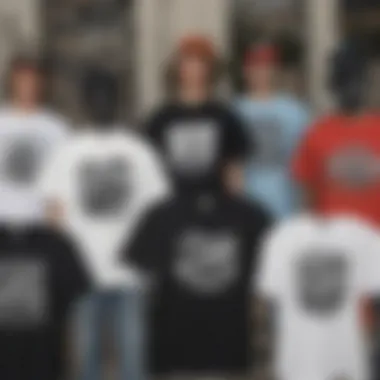

Versatility in style allows skateboarding clothing to transition smoothly from the skatepark to the street. Low key clothing isn’t just about skate culture anymore; it seamlessly weaves itself into everyday fashion. A skateboarder can easily move from practicing tricks to hanging out with friends without needing a complete wardrobe change.
Popular low key pieces include:
- Oversized Tees: Providing comfort and room for movement.
- Cargo Pants: These offer both durability and ample pocket space, perfect for carrying skate essentials.
- Hoodies: A staple that pairs well with almost anything, serving both warmth and style.
The beauty lies in how skateboarders can creatively mix and match these pieces, helping them express individuality while keeping it low key.
"Low key clothing is about being authentic. It’s not just about what you wear; it’s about how you wear it."
As skateboarders navigate their environment, the key elements of low key clothing evolve, reflecting both personal and cultural values. With the balance of comfort, functionality, and versatility, these elements remain integral to skate culture, creating not just a look but a lifestyle.
Fashion vs. Functionality
In the world of skate culture, the interplay between fashion and functionality creates a compelling narrative. Skateboarding, rooted in self-expression and freedom, finds its essence in clothing choices that both look good and perform well. Low key clothing embraces this duality, representing a belief that style shouldn’t compromise comfort or practicality while skating.
The Balance of Aesthetic and Practicality
Striking the right balance between aesthetic and practicality is no small feat, yet it's the cornerstone of low key clothing. Skateboarding is inherently dynamic; it involves a level of movement that requires clothes designed to withstand activities without adding unnecessary bulk or weight. Skateboarders turn to durable fabrics that endure wear and tear, allowing them to move freely.
Fashion also plays a pivotal role. Skaters often wear brands like Vans or Supreme as a badge of identity – it speaks volumes about their taste and ties them to the community. When looking at street art or graffiti, one can see a strong reflection of individuality, and this aesthetic is mirrored in the styles skateboarders choose.
- Durability: Fabrics should resist ripping, snagging, and fading.
- Fit: Clothing needs to be fitted enough to avoid excess fabric getting in the way but loose enough for mobility.
- Design: Simple colors and patterns often take center stage, reflecting a laid-back attitude that does not scream for attention.
This balance means not only looking good while skating but also feeling confident and comfortable performing tricks. It's the difference between a skater executing a flawless ollie or feeling restricted in their attire.
Choosing the Right Clothing for Skating
When it comes to choosing the right clothing for skating, practicality must guide decision-making without overshadowing personal style. Let's explore the key considerations for skaters:
- Material Choices: Look for materials that wick sweat and allow for breathability. Cotton blends have long been favorites, but new innovations in synthetic fabrics provide excellent alternatives.
- Layering: Weather often poses challenges. Lightweight jackets or hoodies can facilitate a quick adjustment between environments while maintaining comfort.
- Footwear: Emphasis on shoes cannot be overstated. Skate shoes need to survive rigorous use, provide adequate support, and offer grip to the board.
- Personal Expression: Remember that skate culture thrives on individuality. Whether it’s a vintage Thrasher T-shirt or a pair of ripped jeans, skaters should choose clothing that resonates with their personal brand.
The harmony of fashion and functionality in skate culture accentuates an individual’s identity, reflecting a lifestyle driven by both aesthetics and practicality.
This understanding remains key as the landscape of skateboarding evolves, enabling skateboarders of all backgrounds to thrive in a community that celebrates both functional needs and fashion sensibilities.
Common Low Key Clothing Choices
When it comes to low key clothing in the realm of skate culture, the choices skateboarders make reflect their identity, lifestyle, and environment. The emphasis is not just on style, but it also encompasses comfort, durability, and individual expression. This section aims to highlight crucial clothing options that resonate with the skateboarding community, emphasizing how these choices are essential for both practicality and personal expression.
Casual Tops and Tee Shirts
Casual tops and tee shirts form the back-bone of low key clothing choices for skaters.
- Comfort and Fit: These pieces should ideally fit loose enough to allow freedom of movement, especially when executing tricks or maneuvering around the skate park. Comfortable cotton blends are common, and designs often feature bold graphics or logos that signal personal interest or allegiance to brands.
- Versatility: A simple tee can transition perfectly from skating to hanging out with friends. Skaters often opt for colors that hide wear and tear but can effortlessly pair with different bottoms. Consideration for layering also plays a role; a lightweight flannel over a t-shirt brings style while allowing ventilation and movement on warmer days.
- Cultural Symbolism: Logos or images reflect skater culture and can serve as badges of identity. Some skaters prefer vintage tees that carry a sense of nostalgia, while others might lean towards locally made brands that align with a more sustainable approach.
Bottoms: Pants and Shorts
Selecting the right bottoms is pivotal for skateboarding as they need to stand up to the rigors of the activity while maintaining comfort and style.
- Durability: Skate jeans and cargo shorts made with tough materials resist abrasions and tearing at the knees. Manufacturers like Levi's and Dickies have developed specific cuts that cater to skaters, blending style and functionality.
- Style Flexibility: Loose-fitting pants or shorts are often preferred, creating space for ease of movement. Interestingly, the bagginess can also serve as a canvas for self-expression, with many opting for custom designs or patches.
- Seasonal Choices: In summer, shorts may become the go-to option, aiding breathability and comfort, while colder months often necessitate pants that can provide warmth without sacrificing mobility.
Footwear Selection
The choice of footwear is arguably the most critical component of low key clothing for skaters, marrying function with flair.
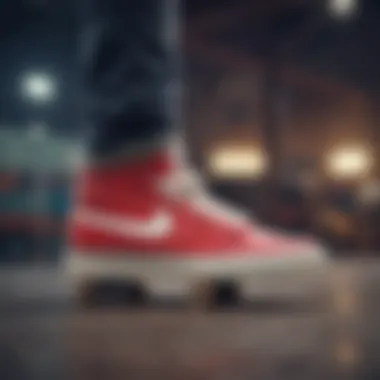

- Grip and Support: Skater shoes from brands like Vans or Nike SB typically feature a rugged sole for grip, ensuring skaters can stick their landings. The upper materials are designed to withstand wear from grip tape yet remain comfortable for extended wear.
- Ankle Support: High-tops are a popular choice for many skateboarders seeking additional ankle support, reducing the risk of injuries during challenging tricks. Unlike many fashion-forward shoes, they prioritize the stability needed for jumping and landing.
- Personal Style: Beyond functionality, footwear serves as a way to express oneself. Different color choices and the signature styles of brands allow skaters to showcase their individuality, often telling a story of their journey or affiliation with a particular skating crew.
"Choosing the right clothing for skateboarding is like picking the right tools for a job. Each piece has to fit well, be durable, and most importantly, express who you are."
Influence of Streetwear on Low Key Clothing
Streetwear and skate culture share an unbreakable bond that extends far beyond mere fashion trends. Understanding the impact of streetwear on low key clothing is essential in grasping how skateboarders express themselves through their choices in attire. Low key clothing, characterized by its understated, comfortable, and functional nature, has been profoundly shaped by elements of streetwear. These two cultures are intertwined, influencing one another while fostering a sense of community and identity among their enthusiasts.
Evolution of Streetwear
Streetwear originated in the late 1970s and early 1980s, emerging from the urban art scene in places like New York City and Los Angeles. It began as a response to the high-fashion realm, being rooted in personal expression and the everyday lives of the youth. Rather than conforming to traditional standards of beauty or image, streetwear was about wearing what felt right—comfortable, affordable, and often with a unique twist.
In its early days, streetwear was heavily influenced by hip-hop culture, graffiti art, and even punk fashion, leading to a melange of styles that were at once experimental and accessible. Brands like Supreme and Stüssy took off, crafting clothing that not only embodied a particular aesthetic but also reflected the values of the communities they represented.
As streetwear evolved, it became a canvas for various subcultures to express their personalities and lived experiences. This adaptability led to its absorption of influences from skate culture, creating a crossover where each discipline could enrich the other.
How Streetwear Culture Shapes Skate Fashion
Streetwear deeply impacts the way skateboarders choose their clothing. The crossover influence can be observed in various aspects:
- Graphics and Logos: Streetwear is notorious for bold graphics and logo-heavy designs. Skateboarding brands adopt this idea, creating apparel that stands out while maintaining a low key vibe.
- Collaborations: Many skateboard brands collaborate with streetwear names, producing limited releases that often become instant classics. This blend allows skateboarders to wear something that resonates with their culture while also being a part of a larger fashion narrative.
- Cultural Statements: Streetwear often reflects social and political issues, giving skateboarders a platform to express their views through clothing. The personal narratives woven into low key pieces resonate with skaters who value authenticity and realness above all.
- Comfort Meets Style: Skate culture emphasizes functional clothing, which naturally aligns with the comfort-first mentality of streetwear. Fabrics that allow for movement while looking stylish are a staple in both cultures.
As skate fashion continues to grow, the influence of streetwear will only deepen, creating a vibrant landscape for personal expression.
"Street culture goes beyond brands; it's about identity and community, telling your story without saying a word."
Whether it’s a graphic tee from Palace or simple joggers from a lesser-known label, the integration of streetwear aesthetics into low key clothing fosters a culture of authenticity, enabling individuals to express their unique identities with every flick of the board.
Personal Expression through Low Key Clothing
In the realm of skate culture, low key clothing emerges not merely as a trend but as a canvas for personal expression. It's a way for skaters to showcase their individuality while embodying the values that define their community. This kind of clothing reflects a deeper narrative, one that resonates with comfort and authenticity—two pillars that underpin the essence of skateboarding.
Individual Style and Identity
Individuality is sacred in skateboarding. Every skater wants to stand apart from the crowd, and low key clothing enables this expression without shouting for attention. Think about it: a well-loved oversized hoodie or a pair of relaxed fit cargo pants often speaks louder than the loudest skate brand logo plastered across a flashy tee.
For many, the choice of clothing becomes an extension of their identity. It’s not just about the look; it's about how a garment feels and how it fits into one’s lifestyle. The solid colors, simple patterns, and practical cuts allow skaters to maintain a laid-back vibe while engaging in their passion. Examples abound in the skate scene, where local skaters have created their signature looks—think of a slightly distressed flannel, paired with a comfortable pair of Vans, reflecting unique influences from the music they love or the art they admire.
Moreover, these clothing choices support a community-centered lifestyle. When a skate session is marked not by competition but by camaraderie, the clothing worn helps signify belonging without exclusion—a subtle nod to others who share similar values.
Customization and DIY Approaches
Customization is where the magic happens. In the skate world, DIY isn’t just a hobby; it’s often a way of life. With many skaters opting to put their own spin on low key clothing, the act of customizing becomes a profound form of expression.
Here are some popular ways skaters channel their creativity into their wardrobes:
- Patches and Badges: Adding personal touches like patches can transform a simple jacket into a narrative tapestry, showcasing one's journey.
- Alteration Techniques: Whether it's distressing or sewing on buttons, these changes provide a sense of ownership and signify experiences, like memorable skate spots visited.
- Unique Dying and Printing: Experimenting with colors and designs can turn a bland piece into a statement item. Some even use tie-dye techniques—an old-school nod that embraces both nostalgia and rebellion.
All these methods not only make clothing distinct but also highlight a deeper connection with the clothing itself. They transform something mass-produced into a one-of-a-kind piece that resonates personally with the skater.
"In every thread and every patch, a skater weaves their story. It’s not just about style; it's about a narrative of who they are."
As a result, low key clothing becomes more than just fabric; it transforms it into an integral part of a skater's journey, fostering a sense of identity and allowing self-expression to thrive.
Social Implications of Low Key Clothing
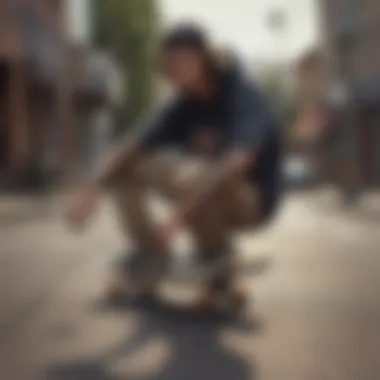

Low key clothing doesn't just serve as a fashion statement; it holds significant societal weight within skate culture. As skaters embrace this style, layers of meaning emerge that encapsulate community, identity, and a sense of belonging, shaping not only personal choice but also collective narratives. Through the lens of low key clothing, we can scrutinize how these garments help convey values of authenticity and inclusion among skateboarders.
Community and Belonging
When one dons low key clothing, it's not merely about comfort or aesthetics—it's about connecting with a community. Low key clothing promotes a relaxed atmosphere, fostering an inviting space where differences are embraced rather than judged. In essence, wearing brands like Baker and Anti-Hero, known for their understated yet recognizable graphics, signals alignment with skateboard culture.
The fabric used in these clothes often carries stories; they might be worn during a session at a local skate park or a laid-back hangout with friends. This garners a sense of camaraderie and a shared experience among skaters. Brands don’t just market to individuals but to a collective identity, creating deep ties amongst wearers.
Another point to note is how this community aspect builds resilience. When skaters support each other through local events, the choice to wear low key garments fosters not just a spirit of belonging, but also a form of social capital. Those in the loop understand the unspoken codes that come with wearing specific items, reinforcing connections. Low key clothing thus serves as a badge of honor—indicating not just membership in the skate community but a deeper appreciation for its ethos.
Status and Authenticity
The relationship between low key clothing and status is complex. While mainstream fashion trends often promote conspicuous consumption, skate culture tends to rebel against this notion. Here, authenticity reigns supreme.
Choosing low key attire—perhaps a plain black crew neck from Thrasher or a pair of Dickies trousers—evokes an image of someone who values substance over style. People within the community know that skateboarding isn’t just about performing tricks; it's also about how one presents themselves. Thus, once you step on a board, your clothing says a lot about your ethos—are you merely a poser, or do you capture the raw, unfiltered essence of skate culture?
Moreover, the idea of authenticity extends beyond fashion; it intertwines with individual stories. Skaters often face scrutiny from those outside the community regarding their lifestyle choices and appearances. When someone chooses a low key outfit, they're not just opting for comfort; they're often echoing a philosophy of remaining true to oneself despite societal pressures.
"In skate culture, what you wear can reflect who you are. So, low key options tell a story—your story."
To sum it up, low key clothing does not simply reflect personal taste; it functions as a medium through which skaters communicate their identity, values, and loyalties. By being intentional in their choices, skaters actively shape how they are viewed and how they view themselves.
The impact of these garments reaches far beyond superficiality; it solidifies relationships, cultivates a sense of belonging, and elevates the importance of authenticity in a world that often prizes the opposite. Through low key clothing, skaters continue to build a culture steeped in inclusivity and genuine self-expression.
Trends and Future Directions in Low Key Clothing
Skate culture has never been a static entity. It continually evolves and adapts, mirroring the changing tides of society at large. It’s crucial to analyze Trends and Future Directions in Low Key Clothing, as it provides insights into how this unique style will transform in the years to come. As skateboarders navigate both street and park, they require a wardrobe that accommodates not only their sport but also their personal expression. The importance of this topic lies in understanding the balance of creativity and functionality that low key clothing offers, ensuring skateboarders remain comfortable while reflecting their individuality.
Emerging Styles and Influences
The streetwear scene is constantly recycling ideas and infusing fresh takes. Emerging styles within low key clothing showcase influences from various realms, including art, technology, and social movements. Individual artists and skaters often bring their personal flair to the mix, creating unique pieces that stand out in a sea of sameness. The blend of skate and high fashion is particularly interesting, where names like Supreme or Aimé Leon Dore play a pivotal role.
These new trends often incorporate colorful graphics, asymmetrical cuts, and unconventional fittings, which might not fit the traditional mold of low key fashion but enliven it with an edge. You can see this in some unexpected clothing choices, like oversized tees paired with sleek joggers or vintage flannel shirts layered for that effortlessly cool vibe.
- Graphic tees display subversive art, a nod to counterculture.
- Layering techniques, combining elements from various styles while remaining practical for skateboarding, are becoming prevalent.
- Incorporation of retro aesthetics is also on the rise, harkening back to eras that influenced skateboarding's early days.
Sustainability in Skate Fashion
With growing awareness around environmental issues, sustainability has found a home in the hearts and wardrobes of modern skateboarders. This is no longer just a buzzword; it’s an urgent priority. Brands that previously focused solely on style are now integrating eco-friendly practices into their production processes, a trend that's becoming increasingly evident in low key clothing.
Using sustainable materials, like organic cotton or recycled fabrics, is taking center stage. Additionally, companies are beginning to offer programs for clothing repair and recycling, aiming to extend the lifespan of garments rather than fostering a throwaway culture. Skate brands that prioritize ethical production are not only appealing to conscious consumers but are also setting new industry standards.
The choices a skateboarder makes about their clothing can reflect their values, allowing them to skate with a sense of purpose. Awareness about where clothing comes from, recognizing waste, and supporting brands with transparent practices can reshape the landscape of skate fashion, infusing it with deeper meaning.
"As the skate culture shifts, low key clothing evolves; it’s not just what you wear on the board, but a reflection of who you are and what you stand for."
End: The Essence of Low Key Clothing
In this exploration of low key clothing, we’ve uncovered a rich tapestry woven with meaning within skate culture. Low key clothing isn’t merely a trend or a passing phase. It’s a testament to the values of comfort, individuality, and practicality. The unique charm of this style lies in its ability to adapt to the fast-paced, often unpredictable nature of skateboarding while allowing for personal flair.
Recap of Key Insights
Let’s take a moment to recap some of the key insights that surfaced throughout our examination:
- Definition and Historical Context: Low key clothing is not just about what you wear; it’s a reflection of skate culture's roots, emerging from its rebellious spirit against mainstream fashion. The styles of the past continue to resonate, emphasizing a laid-back, effortless approach that directly contrasts with the often flashy trends of contemporary fashion.
- Key Elements: Comfort is king. Skateboarding demands clothing that offers ease of movement. Materials that withstand wear and tear, as well as those that breathe — think cotton blends and lightweight synthetics — are vital.
- Fashion vs. Functionality: Successfully balancing style with function is critical. While many clothing items may look good, they might not perform well under the demands of skating.
- Cultural Impact: The community aspect of skateboarding deeply influences clothing choices. Wearing specific brands or styles can signify belonging or authenticity within the skateboarder community.
Final Thoughts on the Cultural Impact
The cultural impact of low key clothing extends beyond mere aesthetics. It’s about connection, freedom, and a shared identity among skateboarders. This style offers an avenue for self-expression, where each outfit tells a story, revealing not only personal taste but also an affiliation with a larger community of like-minded individuals. The brands associated with low key clothing, like Vans or Thrasher, have cultivated an image that embodies the skate lifestyle, asserting influence over youth culture globally.
As we move forward, it’s crucial to recognize that low key clothing continues to evolve, adjusting to new influences and societal changes. Its significance lies not only in how skateboarders dress but also in the lifestyle that surrounds it. Whether you’re cruising on your deck or hanging at the local skate park, the essence of low key clothing resonates: it’s about being true to yourself, comfortable in your skin, and expressing your identity without saying a word.
As we draw this discussion to a close, take a moment to appreciate the subtle power of low key clothing in shaping not just the style but also the very ethos of skate culture.

